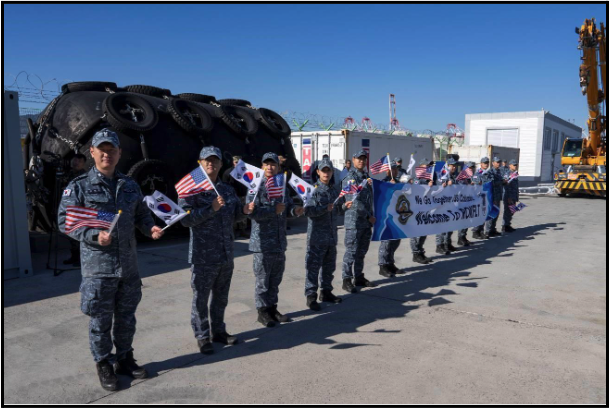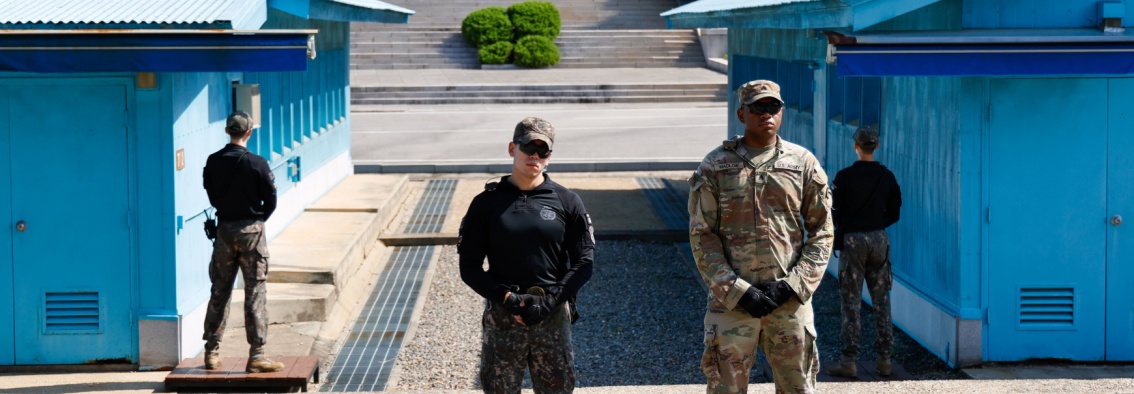With tensions rising in East Asia, the likelihood of a dual contingency—both in the Taiwan Strait and on the Korean Peninsula—is far from a hypothetical scenario. A simultaneous contingency—where war breaks out concurrently in the Taiwan Strait and on the Korean Peninsula—would generate deeply complex strategic challenges for the United States and its allies in the region. Under such grave conditions, South Korea would undoubtedly face strategic, operational, and legal constraints in assisting Taiwan. Nevertheless, despite such constraints, South Korea could still take concrete steps to meaningfully deter the aggressors and help a US-led coalition mount an effective response.
Legal and Strategic Constraints
Unlike Japan and Australia, South Korea’s allied security commitment is narrowly defined to threats stemming from the Korean Peninsula. The US-Republic of Korea (ROK) Mutual Defense Treaty, signed in 1953, does not require Seoul to respond to external military emergencies such as a Taiwan conflict. Although the treaty does not preclude voluntary cooperation, it does not impose any legal duty on South Korea to act in overseas crises.
Moreover, South Korea’s immediate mission during a dual contingency would be the defense of its own territory. According to a US Congressional Research Service report, the Trump Administration had considered withdrawing up to 4,500 US troops from Korea (although this has been denied by US officials). Such indications reflect how fragile the US commitment to Korea might be during a large-scale crisis in the Indo-Pacific. Under such circumstances, South Korea’s strategic options would be severely constrained, and national survival would take precedence over managing crises in distant theaters.
Nevertheless, South Korea’s geographic location, military strength, and alliance network could still provide meaningful strategic utility in a dual contingency—especially if closely coordinated with US and Japanese policymakers.
Three Ways That South Korea Could Contribute
South Korea could, albeit in a constrained way, offer tangible support to Taiwan through the following three approaches: safeguarding sea lines of communication (SLOCs), enabling allied mobility, and preserving overall deterrence on the Korean Peninsula.
Safeguarding the SLOCs Near the Taiwan Strait
Given South Korea’s high dependence on international trade, its economic viability hinges on securing SLOCs. Roughly 90 percent of South Korea’s oil imports transit through the South China Sea, including key chokepoints such as the Malacca Strait, the Bashi Channel, and the Luzon Strait. These maritime routes are located near the Taiwan Strait and are essential for South Korea’s access to Middle Eastern and Southeast Asian energy. Any conflict in these areas would result in significant strategic consequences. In a Taiwan contingency, such routes would likely be contested by the People’s Liberation Army Navy (PLAN).
In this context, deploying South Korean Navy (ROKN) assets—including destroyers, submarines, and support vessels—would achieve two purposes: this could safeguard South Korea’s economic lifelines and contribute as a participant in a naval coalition aiming to counter China’s efforts to dominate strategic waterways. Although such efforts by South Korea would not amount to direct combat, they would undoubtedly play a crucial role in bolstering regional deterrence and improving the operational flexibility of allied naval forces.

Image: ROK Navy sailors wave flags to welcome Los Angeles-class fast-attack submarine USS Columbia to South Korea’s Busan Naval Base on November 18, 2024. (Image source: Wikimedia Commons.)
Supporting Taiwan by Facilitating United States Forces Korea Redeployment
Although the chance of South Korea sending combat troops and warships directly to Taiwan is low, it could still assist by allowing effective redeployment of US forces stationed on its soil, which are collectively under the command of United States Forces Korea (USFK). Currently, United States Forces Korea maintains a variety of military installations in South Korea, including Osan and Kunsan Air Bases, a detachment at the Busan Naval Base, and the Camp Humphreys US Army headquarters.
Through cooperation with the Indo-Pacific Command, Seoul could ease the burden of US forces needed in Taiwan by allowing part of the resources of United States Forces Korea to be shifted to the Taiwan theater, while reinforcing its own defenses. In this scenario, United States Forces Korea could serve as a rear-area staging point for the Taiwan crisis, while South Korea remained prepared to counter North Korean threats. For this to occur, prior US-ROK bilateral planning would be needed to resolve issues such as command-and-control authority, domestic political concerns, and logistics coordination. The South Korean public might oppose the idea of supporting Taiwan due to concerns about unnecessarily provoking China. In response, the South Korean government could tell the public that supporting the United States in this case would enhance US-ROK alliance credibility, thereby signaling to North Korea that, in the event of a Korean contingency, it would be reasonably predictable for the United States to honor its commitment.
Deterring North Korea’s Strategic Opportunism
The most critical way for South Korea to indirectly support Taiwan would be to prevent North Korean aggression from spilling out into other parts of the region, such as Japan. Based on my interviews with several Japanese Self-Defense Force officers, a considerable portion of Japan’s air and naval forces would be allocated to Taiwan in a crisis. This could reduce Japan’s ability to assist US forces during a Korean contingency. In short, although Japan’s potential role has been expanded in the case of a dual contingency—as outlined in Japan’s collective self-defense posture and the 2015 US-Japan Defense Guidelines—US Forces Japan (USFJ) would still prioritize Taiwan’s defense over South Korea, which physically limits Japan’s ability to help South Korea in a dual contingency.
Historically, North Korea has exploited windows of distraction to escalate. For example, it withdrew from the Non-Proliferation Treaty (NPT) during the 2003 Iraq War and stepped up missile launches amid the peak of the Russia–Ukraine conflict. Based on this pattern, North Korea could view a Taiwan contingency as a strategic opening. In such a scenario, South Korea must strengthen its deterrent posture and assure the United States and Japan that the Korean theater is under control. This would require preemptive deployment of missile defense systems, counter-battery capabilities, and rapid-reaction units along the Demilitarized Zone (DMZ).
This possibility was examined in the Atlantic Council’s recent report, A Rising Nuclear Double-Threat in East Asia: Insight from our Guardian Tiger I and II Tabletop Exercises, which explored the risk of North Korea using tactical nuclear arms against South Korea. The report emphasized that such a development would impose serious strain on both South Korean and US forces.
Tabletop Exercises for Realistic Integration
To make these measures effective, more than goodwill is needed. Detailed planning and practical drills are essential. One of the most impactful initiatives would be the institutionalization of US-Japan-ROK trilateral tabletop exercises (TTXs), tailored to a dual contingency.
These exercises should address force distribution, logistics frameworks, communication systems, and political signaling. They must also cover the gray area between support roles and direct combat—which is where South Korea could make its most distinctive contribution. From a strategic standpoint, Taiwan and the Korean Peninsula are interconnected; thus, incorporating South Korea’s viewpoint in Taiwan-related planning is not optional but essential.
The 2023 Camp David Summit between the United States, Japan, and South Korea laid the groundwork for such trilateral action. At the summit, the three leaders agreed to institutionalize annual trilateral meetings, conduct multi-domain military exercises in a regular manner, and enhance data sharing of real-time missile warning.
The time has come to translate shared principles into implementation plans—defining the process for repositioning United States Forces Korea assets, ensuring successful Korean Peninsula deterrence, and executing engagement protocols near Taiwan.
The Need for Strategic Clarity
Even indirect involvement could subject South Korea to political and economic backlash. For example, maritime patrols around the Taiwan Strait and logistical support for United States Forces Korea redeployment could prompt Chinese retaliation in forms such as cyberattacks, economic sanctions, or gray-zone incursions. Given its dependence on the Chinese market, South Korea would face substantial exposure. Additionally, public perceptions that South Korea is becoming too deeply entangled in Taiwan’s defense could provoke domestic opposition.
This dilemma illustrates that inaction also carries risks. South Korea must be prepared to justify its actions to the public on grounds of national interest and alliance commitments, while also remaining alert to how adversaries may exploit strategic ambiguity.
Political Decisions and Strategic Vision
In a dual contingency, South Korea’s contribution to Taiwan’s defense cannot—and should not—reach the same level as that of the United States or Japan. The ROK’s top priority will be to defend its own sovereignty and citizens. Yet, this does not limit South Korea to a passive observer while the region descends into chaos. Indirect engagement, deterrence stability, and force support are all viable policy options that Seoul can pursue to promote Taiwan’s defense.
Implementing these actions will be politically and operationally difficult. Domestic divides, unequal alliance roles, and practical constraints will pose significant hurdles. However, waiting until a conflict breaks out would be too late. South Korea’s strategic function in a Taiwan crisis must be defined while there is still room for coordination, credibility, and foresight.
The main point: Despite legal and operational constraints, South Korea could support Taiwan in three critical ways—securing SLOCs, enabling the redeployment of United States Forces Korea to Taiwan, and bolstering deterrence on the Korean Peninsula. In order to achieve this, trilateral US-Japan-ROK planning and drills must be firmly institutionalized.





